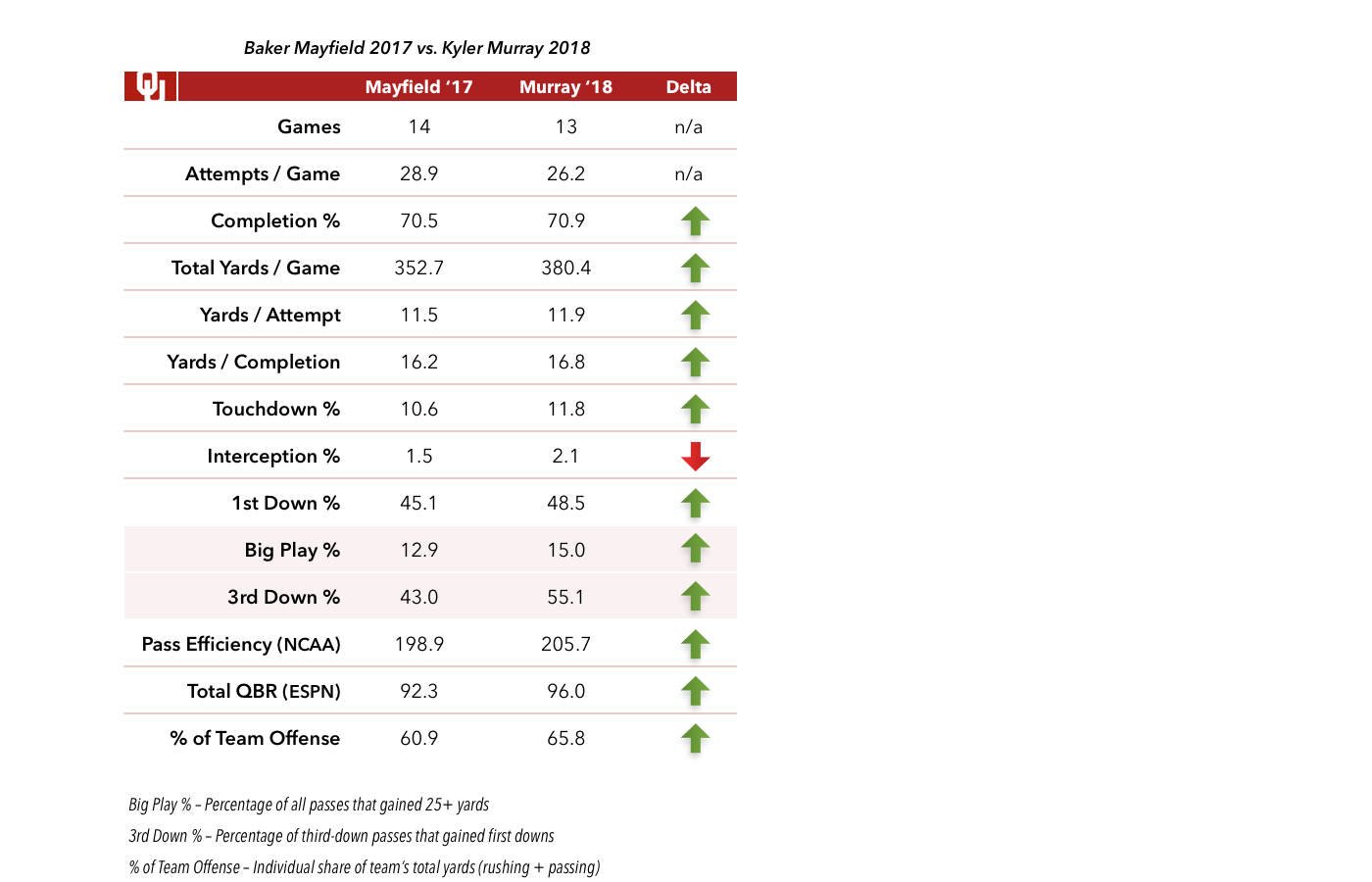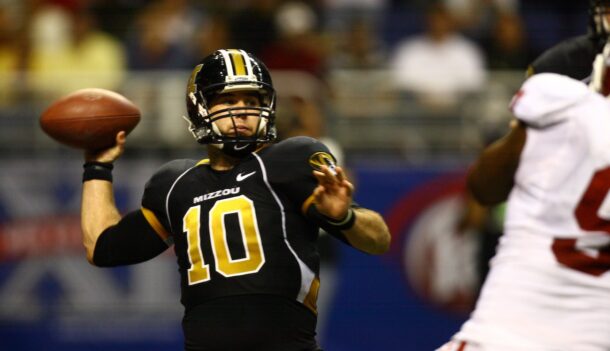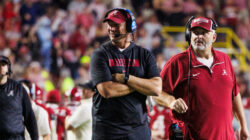
First Look: The least Alabama fans should know about Oklahoma, King of the Shootout
By Matt Hinton
Published:
The Playoff field is set, which means it’s time for SEC fans is to get up to speed on the opposition. Here’s your need-to-know primer on Alabama’s counterpart in the Orange Bowl: Oklahoma.
1. Kyler Murray is for real
Murray has much stiffer competition going into Heisman weekend than his prolific predecessor, Baker Mayfield, whose triumph in NYC was a foregone conclusion. But that says more about the competition than it does about Murray, who has matched or exceeded Mayfield’s 2017 production across the board:

That’s not strictly an apples-to-apples comparison, given that the 14th game in Mayfield’s column — a 54-48, double-overtime loss to Georgia in the Rose Bowl — actually dragged his stat line down, even after he accounted for 290 yards and 3 touchdowns. Efficiency-wise, Murray is on a record pace; to sustain it against Alabama he’ll have to be nearly perfect.
As the numbers indicate, though, perfection is not out of the question. For a guy who still plans to give up football for good at the end of the season, Murray has been a revelation, emerging as arguably the most consistent quarterback in the college game and the most explosive; he ranks second nationally in completion percentage and first in plays covering at least 40 yards.
He’s certainly the most elusive, weaving his way to nearly 1,000 rushing yards before subtracting for sacks, and the fastest, with an extra gear in the open field that makes him a threat to take it the distance from any point. And make no mistake: Despite his size (officially: 5-10, 195 pounds, which is likely generous on both counts), Murray boasts a legitimately live arm, one worthy of both the 5-star rating he earned out of high school and the nearly $5 million contract he signed last summer to play center field for the Oakland A’s.
https://twitter.com/the_LGG/status/1061381547964747777
tl;dr: Murray is a world-class athlete who has looked the part of a Heisman contender in every game, in a system that’s proven it can put the torch to blue-chip defense from outside the Big 12. No aspect of the playbook that took Oklahoma to the brink of the national championship game in 2017 has been lost in translation.
2. It’s a balanced attack with no obvious weak links
There’s a misconception around the country that Oklahoma’s offense is a one-dimensional, Air Raid-inspired scheme that thrives on pushing the tempo and putting the ball in the air as often as possible, which isn’t true and hasn’t been for several years.
It is true that coach Lincoln Riley cut his teeth in the Air Raid, as both a player and an assistant under Mike Leach, and he has an enviable array of downfield weapons at his disposal. The top receivers, Marquise Brown (whose status is unknown after suffering a leg injury in the Big 12 title game) and CeeDee Lamb, both eclipsed 1,000 yards this season, with the blazing-fast Brown likely destined for All-America honors over the coming weeks. The secondary targets, WR Lee Morris, TE Grant Calcaterra, and H-back Carson Meier, collectively averaged 17.9 yards per catch with 18 touchdowns between them.
Defying the high-flying stereotype, though, the Sooners have generated those returns on just 28 passes per game, below the national average and slightly fewer than Alabama.
The rest of the time, they’re running. Even without preseason headliner Rodney Anderson, victim of a season-ending knee injury in Week 2, Oklahoma easily led the Big 12 in rushing for the second consecutive year, with a yards-per-carry average (6.7) that ranks second nationally, trailing only Clemson; that number outpaces the second-best rushing attack in the Big 12 by almost 2 full yards per carry. In Anderson’s absence, sophomore Trey Sermon and redshirt freshman Kennedy Brooks combined for more than 2,000 yards and 24 touchdowns, with Brooks — a fourth-stringer at the beginning of the season — averaging an absurd 9.0 yards a pop. Then (by the way) there’s Murray, who often functions as a de facto running back on designed runs.
The ruthless efficiency of this outfit is a credit to Riley, who’s widely regarded at all levels as an offensive innovator par excellence. Even more so, it’s a credit to OU’s long-in-the-tooth offensive line, a nasty, veteran front that ranks fifth nationally in Line Yards and features three first-team All-Big 12 picks (Cody Ford, Ben Powers, and Dru Samia) among the starting five. That trio has started every game this season, as had left tackle Bobby Evans, a second-team all-conference pick; the center, redshirt freshman Creed Humphrey, has been entrenched since mid-September. Altogether, that group will roll into the Orange Bowl with a combined 154 career starts under their belts.
3. The defense is as bad as advertised …
Worse, in fact. I don’t mean mean “bad by the standards of a Playoff team,” like the 2017 defense, or “lol Big 12 defense” in some generic sense. The Sooners are straight-up bad, by any standard. In October, Riley fired long-time defensive coordinator Mike Stoops in the wake of a wild, 48-45 loss to Texas, and it’s been downhill from there.
For the year, Oklahoma ranks among the bottom 40 nationally in scoring defense (96th), yards per play allowed (102nd), pass efficiency defense (106th), total defense (108th), third-down defense (116th), takeaways (119th), first downs allowed (121st) and passing defense (129th, tied for dead last).
They’re only marginally better in the advanced metrics, coming in 89th overall per Defensive S&P+ and 91st according to ESPN’s Football Power Index.
In November, the Sooners won four consecutive games in which they allowed at least 40 points, an unprecedented run that included a 48-47 shootout at Oklahoma State decided on a failed 2-point conversion by the Cowboys; a 55-40 win over Kansas in which the perennially last-place Jayhawks churned out 348 yards rushing; and a 59-56 scorcher at West Virginia that saw the Mountaineers ring up 704 yards of total offense on a Friday night. No other D-I team has won more than two consecutive while giving up 40-plus since the introduction of the AP poll, in 1936.
Predictably, the secondary has taken the lion’s share of the heat, especially junior cornerback Parnell Motley, who lost his starting job at midseason to sophomore Tre Brown and has continued to find himself on the wrong end of opponents’ highlight reels.
But the back end hasn’t gotten much help from the front, which has been inconsistent vs. the run and mediocre at best on the pass rush.
Last year, Oklahoma at least had the benefit of an explosive, NFL-ready edge rusher, Obo Okoronkwo, whose frequent presence in opposing backfields made up for a lot of other problems. No one in the current lineup poses that kind of reliable, every-down threat, forcing the Sooners to resort to blitzes to generate pressure and leaving them vulnerable to big plays as a result.
Watch every angle of Tre Brown's hit on Sam Ehlinger.#BoomerSooner https://t.co/XZLZeEduRL
— ???????? ??. ??? ????? (@soonergridiron) December 3, 2018
4. … but it has its moments
In that context, OU’s 39-27 win over Texas in the Big 12 Championship Game qualified as an encouraging performance: The Longhorns finished with just 88 yards rushing, didn’t connect on any huge plays in the passing game (their longest completion covered 32 yards), and failed to score at all in the fourth quarter. Rather than the usual sprint to the finish, UT’s last three drives ended with a punt, a safety, and a game-clinching interception.
In one sense that was typical — even on its worst days, the defense has come up with enough timely stops and momentum-shifting plays to keep its head above water.
Against West Virginia, the Sooners managed just five stops on 13 possessions, but two were forced fumbles that went the other way for defensive touchdowns that ultimately made the difference in the game. On the first, linebacker Caleb Kelly offered a rare glimpse of his 5-star potential by flattening a blocker, stripping West Virginia QB Will Grier, and taking it to the house himself:
Yeah I'd say Caleb Kelly won this rep pic.twitter.com/XS7YFRogu5
— Max Olson (@max_olson) November 24, 2018
On the second, true freshman Ronnie Perkins supplied the pressure, initiating a slapstick sequence that ended with Curtis Bolton running free for what turned out to be the decisive score:
???TOUCHDOWN???
Ronnie Perkins with the pressure.
Kenneth Mann with the strip.
Curtis Bolton with the scoop and score.#BoomerSooner https://t.co/g1SLfI6d6K
— ???????? ??. ??? ????? (@soonergridiron) November 24, 2018
If Oklahoma has any chance of turning up the heat on Tua Tagovailoa, it’s most likely going to come from Perkins, another blue-chip recruit who took over Okoronkwo’s old position at “Jack” linebacker at midseason; he leads all freshmen nationally with five sacks on the year, which also leads the team.
If the matchup plays out as expected, he might be the Sooners’ best hope of actually getting Bama’s offense off the field.
Matt Hinton, author of 'Monday Down South' and our resident QB guru, has previously written for Dr. Saturday, CBS and Grantland.







